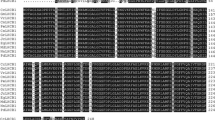Abstract
A cDNA showing high sequence similarity (>70%) to plant protein phosphatase 1 catalytic subunit variants from other species has been isolated from a cDNA library derived from mRNAs expressed in elicitor-treated suspension-cultured cells. The clone appears to be a near full-length 1431 bp with a 172 bp 5′-untranslated region and a 317 bp 3′-untranslated region. The open reading frame, determined by sequence similarity, codes for a protein with predicted M r of 35552. Alternatively an ATG situated to the 5′ end of the putative start site would increase the protein size by 6 amino acids.
The mRNA for Pvpp1 was shown to be rapidly induced by elicitor treatment of suspension-cultured cells of French bean. The cloned cDNA represents one of the few examples of a gene product that is probably involved in dephosphorylation events arising after the initial responses to biotic stress.
Similar content being viewed by others
Abbreviations
- PAL:
-
phenylalanine ammonia-lyase
- PP1:
-
protein phosphatase 1
- Pvpp1:
-
Phaseolus vulgaris protein phosphatase 1
References
Bolwell GP: A role for phosphorylation in the down regulation of phenylalanine ammonia-lyase in suspension-cultured cells of French bean. Phytochemistry 31: 4081–4086 (1992).
Bolwell GP, Mavandad M, Millar DJ, Edwards KJ, Schuch W, Dixon RA: Inhibition of mRNA levels and activities by trans-cinnamic acid in elicitor-treated bean cells. Phytochemistry 27: 2109–2117 (1988).
Bolwell GP, Coulson V, Rodgers MW, Murphy DL, Jones D: Modulation of the elicitor response in cultured French bean cells and its implication for the mechanism of signal transduction. Phytochemistry 30: 397–405 (1991).
Bolwell GP, Davies DR, Gerrish C: The role of phosphorylation in the regulation of phenylalanine ammonialyase. In: Shewry P, Hooley R, Halford N (eds) Protein Phosphorylation in Plants. Oxford University Press, Oxford, UK, in press (1995).
Dietrich A, Mayer JE, Hahlbrock K: Fungal elicitor triggers rapid, transient and specific protein phosphorylation in parsley cell suspension cultures. J Biol Chem 265: 6360–6368 (1990).
Dixon RA, Lamb CJ: Stimulation of de novo synthesis of L-phenylalanine ammonia-lyase in relation to phytoalexin accumulation in Colletotrichum lindemuthianum elicitor-treated cell suspension cultures of French bean (Phaseolus vulgaris). Biochim Biophys Acta 586: 453–463 (1979).
Farmer EE, Pearce G, Ryan CA: In vitro phosphorylation of plant plasmalemma proteins in response to the proteinase inhibitor inducing factor. Proc Natl Acad Sci USA 86: 1539–1542 (1989).
Felix G, Grosskopf DG, Regenass M, Boller T: Rapid changes of protein phosphorylation are involved in transduction of the elicitor signal in plant cells. Proc Natl Acad Sci USA 88: 8831–8834 (1991).
Felix G, Grosskopf DG, Regenass M, Boller T: Specific perception of subnanomolar concentrations of chitin fragments by tomato cells: inducition of extracellular alkalinization, changes in protein phosphorylation and establishment of a refractory state. Plant J 4: 307–315 (1993).
Ferreira PCG, Hemerley AS, Van Montagu M, Inze D: A protein phophatase 1 from Arabidopsis thaliana restores temperature sensitivity of a Schizosaccharomyces pombe cdc25ts/wee 1- double mutant. Plant J 4: 81–87 (1993).
Grab D, Feger M, Ebel J: An endogenous factor from soybean (Glycine max L.) cell cultures activates phosphorylation of a protein which is dephosphorylated in vivo in elicitor challenged cells. Planta 179: 340–348 (1989).
Hardie G: Biochemical Messengers. Chapman and Hall, London/New York (1991).
MacKintosh C, Cohen P: Identification of high levels of type 1 and type 2A protein phosphatases in higher plants. Biochem J 262: 335–339 (1989).
MacKintosh RW, Haycox G, Hardie DG, Cohen PTW: Identification by molecular cloning of two cDNA sequences from the plant Brassica napus which are very similar to mammalian protein phosphatases-1 and-2A. FEBS Lett 276: 156–160 (1990).
MacKintosh C, Coggins J, Cohen P: Plant protein phosphatases: subcellular distribution, detection of protein phosphatase 2C and identification of protein phosphatase 2A as the major quinate dehydrogenase phosphatase. Biochem J 273: 733–738 (1991).
MacKintosh C, Lyon GD, MacKintosh RW: Protein phosphatase inhibitors activate anti-fungal defence responses of soybean cotyledons and cell cultures. Plant J 5: 137–147 (1994).
Mehdy MC: Active oxygen species in plant defence against pathogens. Plant Physiol 105: 467–472 (1994).
Nitschke K, Fleig U, Schell J, Palme K: Complementation of the cs dis 2–11 cell cycle mutant of Schizosaccharomyces pombe by a protein phosphatase from Arabidopsis thaliana. EMBO J 11: 1327–1333 (1992).
Pay A, Pirck M, Bogre L, Hirt H, Heberle-Bors E: Isolation and characterisation of protein phosphatase 1 from alfalfa. Mol Gen Genet 244: 176–182 (1994).
Robertson D, Davies DR, Gerish C, Jupe SC, Bolwell GP: Rapid changes in oxidative metabolism as a consequence of elicitor treatment of suspension-cultured cells of French bean (Phaseolus vulgaris L.). Plant Mol Biol 27: 59–67 (1995).
Rundle SJ, Nasrallah JB: Molecular characterisation of type 1 serine/threonine phosphatases from Brassica oleracea. Plant Mol Biol 20: 367–375 (1992).
Shewry P, Hooley R, Halford N: Protein Phosphorylation in Plants. Oxford University Press, Oxford (1995).
Showalter AM, Bell JN, Cramer CL, Bailey JA, Varner JE, Lamb CJ: Accumulation of hydroxyproline-rich glycoprotein in response to fungal elicitor and infection. Proc Natl Acad Sci USA 82: 6551–6555 (1985).
Smith RD, Walker JC: Isolation and expression of a maize type 1 protein phosphatase. Plant Physiol 97: 677–683 (1991).
Smith RD, Walker JC: Expression of multiple type 1 phosphoprotein phosphatases in Arabidopsis thaliana. Plant Mol Biol 21: 307–316 (1993).
Yu L, Lamb CJ, Dixon RA: Purification and biochemical characterisation of proteins which bind to the H-box cis-element implicated in transcriptional activation of plant defense genes. Plant J 3: 805–819 (1993).
Author information
Authors and Affiliations
Rights and permissions
About this article
Cite this article
Zimmerlin, A., Jupe, S.C. & Bolwell, G.P. Molecular cloning of the cDNA encoding a stress-inducible protein phosphatase 1 (PP1) catalytic subunit from French bean (Phaseolus vulgaris L.). Plant Mol Biol 28, 363–368 (1995). https://doi.org/10.1007/BF00020386
Received:
Accepted:
Issue Date:
DOI: https://doi.org/10.1007/BF00020386




